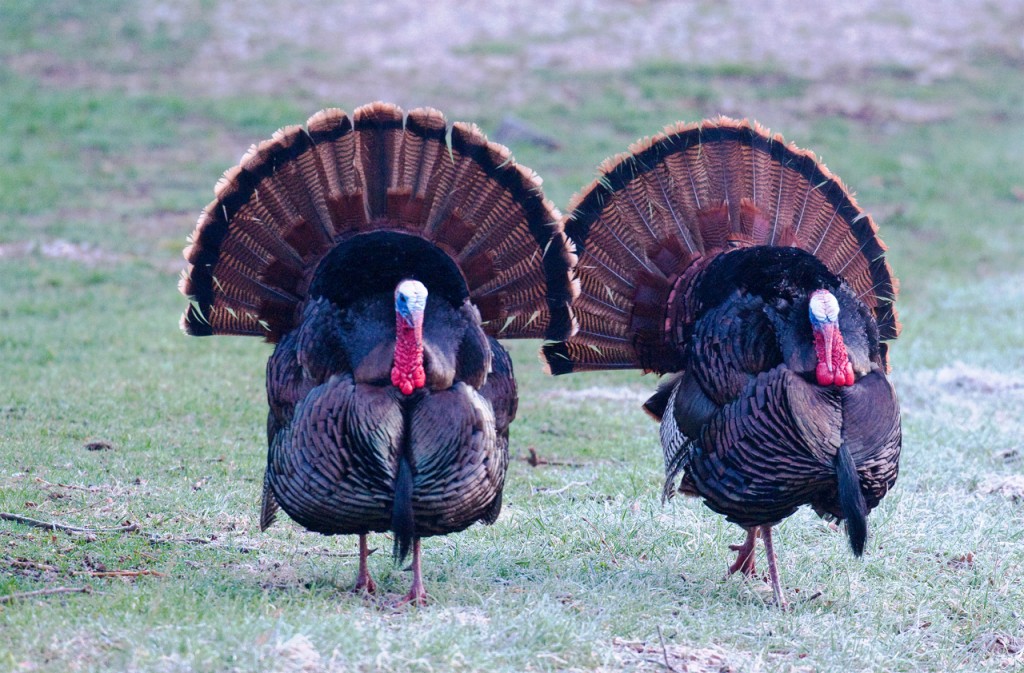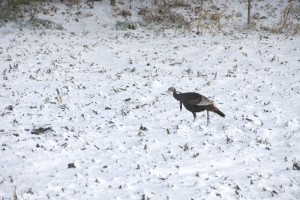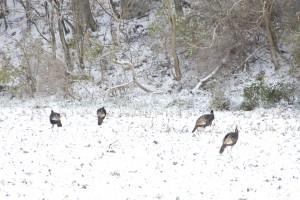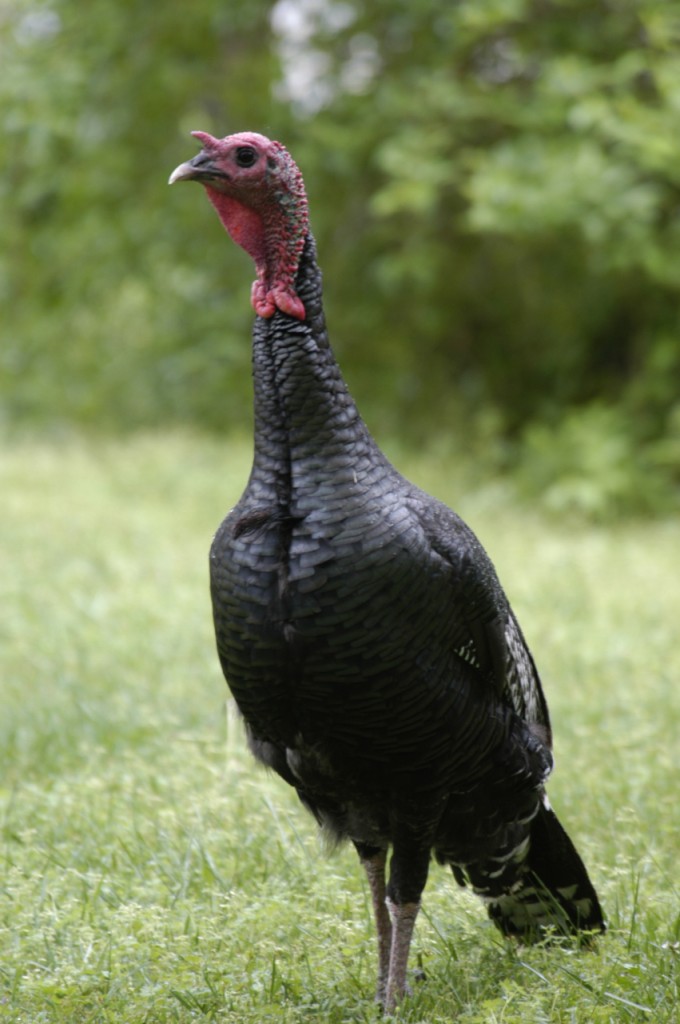Wild Turkeys: Bellwether Birds of Healthy Habitats
Wild turkeys are a magnificent bellwether bird, proof positive that our bluff land forests afford healthy and sustainable habitats for a variety of wildlife.
Wild turkeys (Meleagrus gallopavo), the largest game bird in North America, have long held a special place in the natural world for peoples of our continent. Many Native American tribes considered turkeys as sacred and provided them with ceremonial burials. Other Amerindian groups – including the Illini – used turkey feathers as offerings to the dead, whose souls, they believed, could then fly to the next world. Native Americans were the first to semi-domesticate turkeys, insuring a ready source of food.
The earliest Spanish explorers in the Western Hemisphere were quick to capitalize on their discovery of the wild turkey. In 1511, the king of Spain ordered that every Spanish ship returning home from the Americas should bring five male and five female turkeys with them. By 1600, turkeys were a common sight in farmyards across Europe. Both the common and scientific names reflect confusion over the species’ land of origin. The scientific name resulted from a perceived resemblance to the African Guinea fowl. The belief that the bird originated in Turkey gave English speakers their name for the bird; but speakers of German, French and Italian all refer to a “cock of Calcutta or of India” in their common names. So, while England’s first colonists in America at Jamestown and Plymouth brought turkeys with them, they may have been somewhat surprised – as well as pleased – to find the birds already here.
Early Euro-American pioneers and settlers had a variety of uses for turkey in addition to food. The sharp spurs on turkey legs were made into arrowheads and the feathers were used to stuff mattresses and pillows. Turkey wings became makeshift brooms while the tails were used as fans.
Wild turkeys, bountiful and ubiquitous in the forests throughout Eastern North America, served as a food mainstay in early America. They came to symbolize the seemingly limitless natural resources of our expanding nation. Benjamin Franklin proposed that the wild turkey become our national mascot in recognition of its industrious strength in defending its nest rather than the Bald Eagle, a bird that, in Franklin’s opinion, was lazy and opportunistic.
The widespread felling and destruction of eastern forest lands and zealous overhunting both for food and for feathers used by clothiers brought a sharp decline in turkey populations in the United States. New England saw its last turkey in 1818. New York’s last turkey died in 1844. In Illinois, wild turkeys were extirpated by 1903.
In 1959, the Illinois Department of Conservation (the precursor of today’s Department of Natural Resources) began releasing wild turkeys that had been captured in other states into southern-most Illinois. In 1973, with the founding of the National Wild Turkey Federation, whole scale, nationwide efforts were begun to prevent the overharvesting of wild turkey populations and to improve habitat for these game birds.
Wild turkey have now returned to all parts of Illinois where suitable habitat is found. Sustaining those habitats is the absolute cornerstone to maintaining healthy and plentiful turkey populations. Wild turkey lifestyle actually demands several types of habitat.
Turkeys are birds of both forest and field. They feed on the ground, often in flocks. When faced with danger they prefer to run, rather than fly, and can reach running speeds of up to 15 miles per hour. At night, turkeys roost in trees, often quite near the top.
In spring, males – Toms – will wander widely and noisily in search of hens. Toms will mate with multiple females. Toms display “mood colors” during breeding season, with the head and neck brightening to vivid hues of red, white and blue in seconds should a hen or another male approach. Males often fight viciously as they compete for hens.
After mating, hens go off by themselves into woodland areas. Each one scratches a shallow depression beneath a shrub, a low branch or brushy pile to make a nest. Egg laying can occur over a period of several days with 10-12 eggs laid in the average clutch. Incubation begins after all the eggs are laid. Whenever the female leaves the nest to forage, she covers the eggs with leaves.
Incubation takes about a month. After hatching, the hen leads the chicks, called “poults,” to brooding areas where they feed themselves a calorie-rich diet of insects and insect larvae. The poults can fly in about two weeks and will follow their mother hen as she flies up into trees to roost for the night. By day, she continues to lead her chicks to food in the brooding areas. Good brood cover is key to the survival of the poults.
Quality brood habitat provides both insect food and offers protection from predators. Fairly tall herbaceous vegetation that is open near the ground fits the chicks’ needs, since insects abound in the green growth which also serves to conceal the poults from predators. Native grass stands, old farm fields and unharvested crop fields, so long as they are located near woodlands, can provide good brood cover.
All grasses, however, are not equal. Non-native grass stands, especially mat-forming ground-hugging non-native fescues can entangle and trap poults. Native grasses, particularly bunch-forming ones such as both big and little bluestem grasses, leave bare-ground patches around which the poults can scurry. Native grasses also harbor many more insects, providing poults with plenty of nutritious “bug bites.”
The chicks mature along with the summer season. By the time they are sub-adults the family groups begin to join others in larger flocks. Brood hens and their poults merge to form groups of 30 or more individual birds. Toms also form flocks of a dozen or so individual males. In the fall, immature males, called “jakes,” often form their own groups of bachelor birds. By winter, however, all the groups split again into small flocks as they retreat deeper and deeper into woodlands in search of food to sustain them through the cold season.
Wild turkeys feed omnivorously as their diet changes with the seasons. The poults that had fed almost exclusively on insects – rich in protein, fats and calcium – quickly turn to plant sources by summer’s end. Turkeys will browse a variety of plant foods, including seeds, leaves and tubers, and, even, field corn and milo. But their dietary staple is the hard and soft mast produced in our area woodlands. Hard mast, acorns and nuts, and soft mast, berries and fruits, are essential to the survival of turkeys for these foods are the mainstays of their diet and their lives.
Written accounts of the earliest explorers and settlers indicate that pre-European- settlement America hosted about 20 million wild turkeys. By 1970 that population numbered about one million birds. Today, after much effort, and no small expense, the wild turkey population has reached around seven million birds.
The successful restoration of wild turkeys – in all of the U.S., in Illinois, and in our bluff lands – has centered on maintaining and improving natural habitat in woodlands. Hard and soft mast production is crucial to the health and sustainability of turkeys and a host of additional game and non-game wildlife. Improving forest health – helping mast producing native trees achieve their wildlife larder filling potential – and maintaining forest edges with native grass and shrubby borders are the keys to wild turkey and wildlife habitats.
Clifftop, a local nonprofit organization, is focused on preserving and protecting area bluff lands.
A version of this article appeared in the October 2 2009 edition of the Monroe County Independent.
© 2009 all content rights reserved, Clifftop NFP.
Comments are currently closed.




